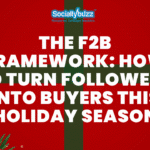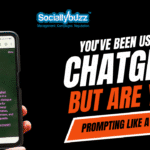
When it comes to holiday marketing, visuals speak louder than words and color is the first thing people notice. Long before they read your caption or click your ad, their brain has already made a judgment based on the palette you’ve chosen.
Color doesn’t just decorate your campaign; it directs emotion, shapes perception, and influences buying decisions. It’s the silent persuader that can make your brand feel festive, trustworthy, luxurious, or even urgent, all without saying a word.
That’s why the most successful holiday campaigns aren’t just beautiful, they’re intentional about every shade they use.
Red and Gold evoke luxury, warmth, and generosity. Red sparks passion and excitement, while gold communicates prestige and abundance. Together, they create a festive energy perfect for brands that want to stand out with confidence and celebration.
Green and White bring a sense of renewal, nature, and purity. Green symbolizes growth and giving, while white adds a fresh, timeless balance. This pairing feels classic and trustworthy, ideal for wellness, sustainability, or family-oriented brands.
Blue and Silver express calm, modernity, and sophistication. Blue builds trust and stability, while silver adds a sleek, futuristic touch. This palette works beautifully for tech, lifestyle, or luxury service brands aiming for a cool and polished aesthetic.
Purple and Gold radiate creativity, royalty, and ambition. Purple signals imagination and individuality, while gold amplifies richness and success. It’s a strong choice for brands that want to feel high-end yet artistic the perfect balance of bold and elegant.
Color psychology isn’t just theory it’s science-backed strategy. Studies show that up to 90% of first impressions are based on color alone.
Warm tones like red and gold stimulate excitement and impulse buying. Cool tones like blue and silver calm the viewer, building trust and long-term loyalty. Green connects to balance and wellness, making people feel safe to invest in themselves.
In short, your palette can set the tone for your customer’s emotional response: excitement, comfort, confidence, or exclusivity, and that response often determines whether they click “buy.”
The secret is to use color intentionally, not generically. You don’t need to follow every trend; you need to follow your brand’s personality.
If your business thrives on energy and joy, add bold reds or metallics that pop. If your brand focuses on calm or minimalism, stay within muted greens, whites, or blues. Always consider contrast and balance; too many competing colors can confuse your message.
And remember: consistency builds recognition. The more your audience associates a color story with your brand, the faster they’ll remember you in a crowded holiday feed.
Coca-Cola’s signature red has long dominated the holidays because it represents energy, joy, and warmth, emotions perfectly aligned with their “Share a Coke” storytelling.
Apple, on the other hand, often uses sleek silver and midnight blue to create a sense of innovation and calm sophistication. It’s not loud, but it’s instantly recognizable.
Even smaller brands have leveraged color for impact from local bakeries using soft greens and whites for a “homemade holiday” vibe to fashion boutiques pairing purple and gold for an elevated festive touch. Each palette tells a story that customers feel before they even read a word.
Every hue carries a message. The question is: what do you want yours to say?
As you plan your holiday campaigns, take time to choose colors that reflect your story, evoke the right emotions, and strengthen your visual identity. Because when your design connects emotionally, your audience doesn’t just notice your brand, they remember it.
Design your next campaign with intention, not guesswork.
1. Why is color psychology important in holiday marketing?
Color psychology helps brands connect emotionally with shoppers. During the holidays, people make fast, emotion-based buying decisions. The right color palette can make your brand feel joyful, luxurious, or trustworthy increasing engagement and conversions without relying solely on discounts.
2. How do colors influence customer buying behavior?
Colors shape how customers feel about your product before they even read your offer. Warm tones like red and gold spark excitement and urgency, while cool tones like blue and silver build calm and trust. Choosing the right color combination can nudge shoppers toward purchase decisions faster.
3. Which holiday color palette is best for my brand?
It depends on your brand personality. Red and gold suit energetic or luxury brands. Green and white work for wellness or eco-friendly businesses. Blue and silver fit tech or modern lifestyles, while purple and gold appeal to creative and premium audiences. Align your palette with your message, not just the trend.
4. Can color alone increase holiday sales?
Color alone won’t guarantee sales, but it can dramatically influence perception and click-through rates. When your visuals evoke the right mood trust, joy, or exclusivity they make your offers more persuasive and memorable, especially in crowded holiday feeds.
5. How can small businesses use color psychology without rebranding?
You don’t need a full rebrand to apply color psychology. Adjust accents, backgrounds, or highlight tones in your campaigns. For example, add gold to create luxury or green to suggest generosity. Subtle shifts can align your seasonal visuals with your brand identity and holiday emotion.
6. What are examples of brands using color effectively during the holidays?
Coca-Cola’s red evokes joy and nostalgia, making it a global holiday symbol. Apple’s silver and blue palette creates calm sophistication that mirrors its innovation message. Even local boutiques use soft greens or purples with gold to build emotional connection and festive appeal.
7. How do I measure the impact of color on my marketing campaigns?
Track engagement metrics such as click-through rates, shares, saves, and conversions before and after color updates. You can also run A/B tests using different palettes in ads or email headers to see which version attracts higher attention or sales.
8. How can I choose holiday colors that stay consistent with my brand identity?
Start by identifying your brand’s core emotion: is it bold and vibrant, calm and refined, or warm and community-driven? Use your base brand colors as anchors, then layer complementary holiday tones. Consistency builds recognition, while seasonal accents add freshness and relevance.
Sociallybuzz is a leading social media marketing, management, and digital advertising agency for small and medium-sized businesses. With over 17 years of experience as one of the first social media marketing agencies in the world, we know how to create and execute marketing campaigns that will help you grow your business. Our social media agency has created successful targeted social media campaigns that acquired our customers more leads, sales, and revenue.
Check out our insights on The Impacts of Social Media Marketing in the Restaurant Industry to see how specific strategies can influence different sectors.
Recommended: Restaurant advertising ideas and tips for food firms
Recommended: Learn How to Create Your Restaurants Social Media Marketing Strategy
Recommended: How to Run Facebook Ads for Restaurants
Read More:









Subscribe now to receive relevant social media information, tips, tricks and service updates.